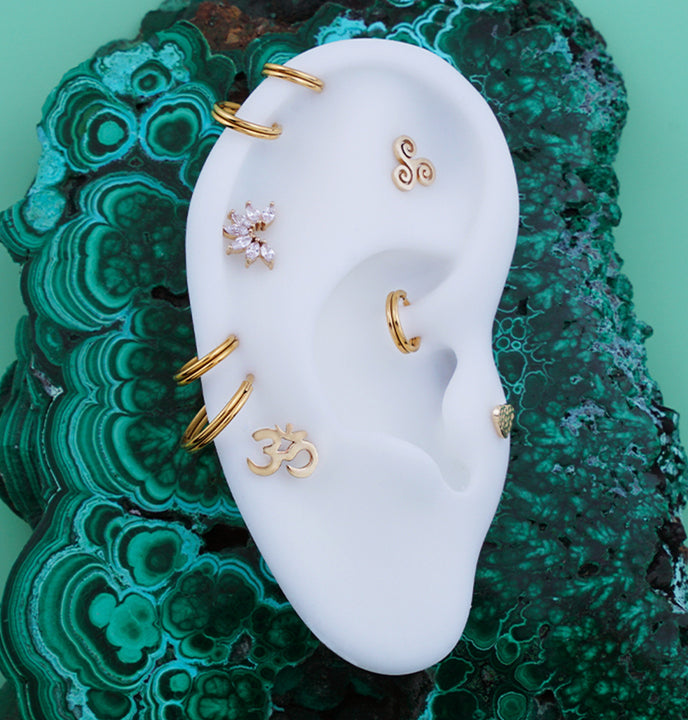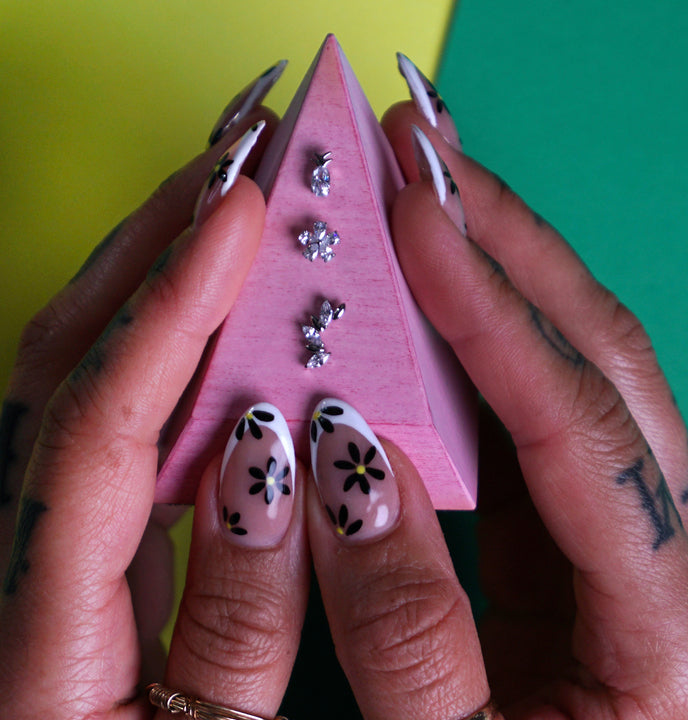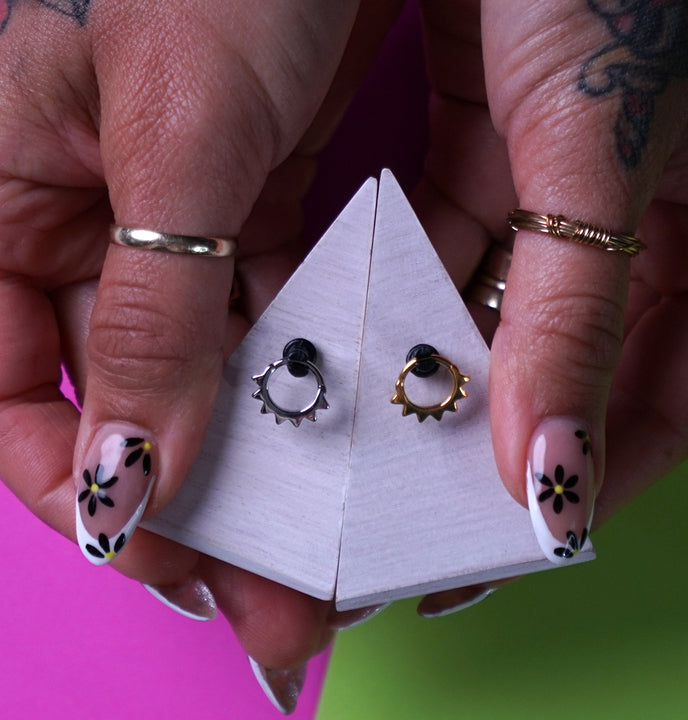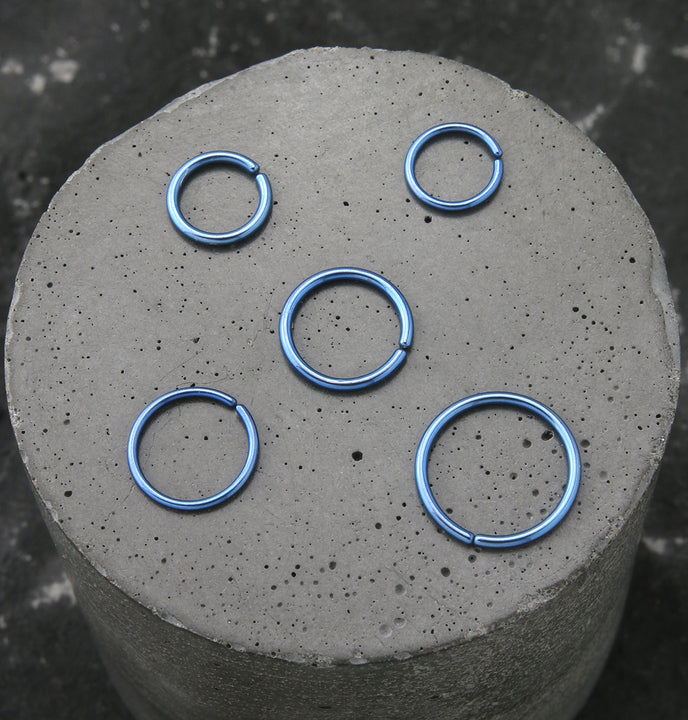Jewelry Guide
Urban Body Jewelry has been a staple in the body piercing industry since its founding in 2009. With a passion for high-quality body jewelry at an affordable price—and creativity that fuels hundreds of original jewelry designs—UBJ has had its finger on the pulse of piercing and jewelry trends for nearly two decades. That’s a whole lot of expertise under one roof.

Solid Gold Body Jewelry
Yellow gold, white gold, rose gold…it’s hard to go wrong with gold. A precious metal to rule them all, pure gold (24k) is too soft for the durability that body jewelry demands. That’s why we offer 14k and 18k gold options that are mixed with other alloys for strength purposes. While gold jewelry is generally hypoallergenic and comfortable to wear, the added alloys can cause irritation for those with metal allergies or sensitive skin.
Care
Gold won’t oxidize or discolor, giving you all the more reason to take care of it! Keep it as lustrous as the day you bought it by gently scrubbing it with a mixture of warm water and dishsoap. In between cleaning your gold jewelry, you can preserve its luster by buffing out smudges with a dry microfiber cloth and storing it somewhere dry.

Titanium Body Jewelry
ASTM F-136 titanium is the metal that experts deem the best for body piercings based on its solid reputation in the realm of surgical implants. It’s also the grade of titanium we use at UBJ. Because it’s lightweight and naturally biocompatible, titanium is optimal for initial piercings and those who have metal allergies or sensitive skin. Titanium can also be anodized to any color in the spectrum, making it an incredibly versatile and attractive jewelry option.
Care
Cleaning and caring for your titanium jewelry is simple. Fill a shallow bowl with dishsoap and warm water and soak the jewelry for a couple minutes. Use a microfiber cloth or soft-bristled brush to scrub away dirt and grime. For titanium jewelry that has gemstones or pearls, avoid submerging it. Instead, spot clean the jewelry by dipping a cloth or brush into soapy water and gently scrubbing the jewelry as needed. Rinse the jewelry with clean water and use a different cloth to polish if desired.

Stainless Steel Body Jewelry
Not all stainless steel is created equal, and that’s why we offer body jewelry made from 316L stainless steel, one of the only acceptable grades for this use. While it’s one of the more common metals used in body jewelry, stainless steel can contain a small amount of nickel that can be irritating to those with metal allergies or sensitive skin. For others, however, stainless steel is a durable and hypoallergenic option.
Care
While stainless steel doesn’t tarnish, it can still lose its luster through built-up residue from sweat and other hygiene products. Fortunately, all you need to clean stainless steel is dishsoap, warm water, and a microfiber cloth and/or soft-bristled brush. For jewelry that’s totally stainless steel, soak your jewelry in soapy water for a couple minutes and use the microfiber or brush to scrub away impurities For stainless steel jewelry with gemstones or pearls, avoid submerging it. Instead, spot clean the jewelry by dipping a cloth or brush into soapy water and gently scrubbing as needed. Rinse the jewelry with clean water and use a different cloth to polish if desired.

Niobium Body Jewelry
Niobium is a relatively new metal in the piercing scene. Comparable to titanium, niobium is completely nickel-free, making it biocompatible and great for those with sensitive skin. It can also be anodized into different colors like titanium. A key difference between the two is that niobium is a pure metal (look for element 41 on the Periodic Table!) that doesn’t need extra alloys to improve its durability. However, niobium may be more expensive because it’s a specialty metal that makes welding a pain and manufacturing a challenge. Also note that niobium is heavier than titanium which is important for those looking for bigger jewelry like plugs or tunnels.
Care
Like stainless steel, a benefit to niobium is that it doesn’t tarnish. To care for your niobium jewelry, simply fill a shallow bowl with dish soap and warm water. For jewelry that’s fully niobium, soak it in the soapy water for a couple minutes and use the microfiber or soft-bristled brush to scrub away any dirt and grime. For niobium jewelry that includes gemstones or pearls, avoid submerging it. Instead, spot clean the jewelry by dipping a cloth or brush into soapy water and gently scrubbing the jewelry as needed. Rinse the jewelry with clean water and use a different cloth to polish if desired.
JEWELRY SIZING
Important note
While this size guide can point you in the right direction, it’s always best to consult with a professional piercer first. They’ll take measurements and/or assess your piercing so you can find the right jewelry fit for your needs.
When it comes to piercings, body jewelry is typically measured in two sizes:
01Gauge (“g”)
02Millimeter (“mm")
Keep in mind that in the United States, gauge measurements are preferred over milimeter measurements. If you need to convert from g to mm, or vice versa, here’s a handy chart:
- GAUGE 20g /18g /16g /14g
- MILIMETERS 0.8 m /1.0 mm /1.2 mm /1.4 mm
Common Piercing Jewelry Sizes
Helix
18G (1/4"), 18G (5/16"), 16G (1/4"), 16G (5/16") Labrets & Barbells.
18G (5/16"), 18G (3/8") - Rings/Hoops
Rook
16G (1/4"), 16G (5/16") - Curved Barbells.
18G (1/4"), 18G (5/16"), 16G (1/4"), 16G (5/16") - Rings/Hoops
Daith
16G (5/16"), 16G (3/8") - Curved Barbells.
16G (5/16"), 16G (3/8") - Rings/Hoops
Tragus
18G (1/4"), 18G (5/16"), 16G (1/4"), 16G (5/16") Labrets & Barbells.
18G (1/4"), 18G (5/16"), 16G (1/4"), 16G (5/16") - Rings/Hoops
Conch
16G (5/16"), 14G (5/16") Labrets & Barbells.
16G (3/8"), 16G (7/16") - Rings/Hoops
Ear Lobes
18G (1/4"), 18G (5/16"), 16G (1/4"), 16G (5/16") Labrets & Barbells.
18G (5/16"), 18G (3/8"), 16G (5/16"), 16G (3/8") and up Rings/Hoops
Forward Helix
18G (1/4"), 18G (5/16") Labrets.
20G (1/4"), 18G (1/4") - Rings/Hoops
Flat
16G (1/4"), 16G (5/16") Labrets
Snug
16G (1/4"), 16G (5/16") Curved Barbells
Industrial
14G (1 & 1/4"), 14G (1 & 3/8"), 14G (1 & 1/2")
Septum
20G (5/16"), 18G (5/16"), 16G (5/16"), 16G (3/8")
Nose Rings
20G (9/32"), 20G (5/16"), 18G (9/32"), 18G (5/16")
Eyebrow
16G (5/16"), 16G (3/8")
Tongue
14G (1/2"), 14G (5/8"), 12G (1/2"), 12G (5/8")
Nipple
14G (1/2"), 14G (9/16"), 14G (5/8"), 12G (1/2"), 12G (5/8")
Belly
14G (3/8")
Labret
18G (5/16"), 16G (5/16")
Snakebites
18G (5/16"), 16G (5/16")
Angel Bites
18G (5/16"), 16G (5/16")
Philtrum
18G (5/16"), 16G (5/16")
Madonna
18G (5/16"), 16G (5/16")
Monroe
18G (5/16"), 16G (5/16")
Ashley
18G (5/16"), 16G (5/16")
Personalize Your Piercing
UBJ believes that body piercings should be safe for and accessible to everyone. That starts with providing valuable insights that can help you make informed decisions to enhance your self expression. Since all bodies are different, use this ear piercings guide to plan for your next body mod or care for your most recent one.

- ALobes
- BStacked Lobe
- CAnti tragus
- DTragus
- EDaith
- FForward Helix
- GIndustrial
- HFlats
- IHelix
- JSnug
- KConch
- LRook
Body Jewelry Glossary
Types of Body Jewelry
Backing/Posts
The part of a piercing stud that holds the jewelry in place, commonly known as a labret. It is the female part of the earring that the post fits inside. The back is typically a disk that lays flat against your lobe to accommodate for any swelling.
Barbell
One of the more common body jewelry options, a barbell is comprised of a metal bar with two “ends” on either side that screw on/off. These “ends” are typically balls but can come in seemingly endless variations of shape, size, and/or gemstones. Barbells can be internally or externally threaded, and they come in three main configurations: straight, curved, and circular.
Straight Barbell
Pair text with an image to focus on your chosen product, collection, or blog post. Add details on availability, style, or even provide a review.
Curved Barbell
Most similar to the straight barbell, the only difference is that the bar in the middle is curved to accommodate piercings located along the body’s natural curves. Curved barbells are extremely versatile, most often worn in the eyebrow, navel, and several ear cartilage piercings.
Circular Barbell
This type of barbell follows the same convention as the others, but the bar is curved into a “U” shape with balls on both ends. Circular barbells are often called “horseshoe barbells” for this reason. These are most commonly worn for septum piercings, but you can also see them in the nipples and ears, too.
Captive Bead Rings
Also known as captive rings or CBRs. Unlike seamless hoops and hinged/segment rings, captive bead rings have a “ball” or bead in the center that screws on/off for installation and removal. This bead can come in many styles and variations, making it a versatile option.
Charms
While charms aren’t used directly in a piercing, they can hang from any kind of cartilage hoop ring. Charms give you the opportunity to express yourself through body jewelry without the hassle of getting a brand-new piercing.
Cuffs
A cuff is a great alternative to a conch or helix piercing. Cuffs simply slip onto the ear, no piercing required, and can be tightened by gently pinching them closed.
Ear Weights
Another type of jewelry specific to those with stretched or gauged ears. This jewelry slides through the gauged lobe to weigh it down, leaving a space between the top of your gauge and the jewelry itself. Choosing ear weights over tunnels or plugs is purely based on personal style preferences. They are NOT to be used as a stretching tool! Ear weights also aren’t meant to be worn permanently and are often made of brass or silver—two materials that aren’t suitable for new piercings or extended wear.
Hinged/Segment Rings
A hinge ring, also called a hinged segment ring, is most commonly worn in the ear and nose. It uses a micro hinge that easily opens and closes a segment of the piercing, adding to its seamless look. Typically, hinge rings are very dainty and thin.
Hoops
These circular, dangly earrings come in a myriad of sizes and styles. They’re typically seen as a “dressier” earring option, especially if the hoop is large.
Huggies
This type of hoop earring “hugs” the ear, leaving little-to-no space between the jewelry and skin. While regular hoops might sway when you move, huggies are meant to stay in place. They typically use a small hinge to secure the jewelry in place.
Labret
This type of body jewelry is akin to a stud. Labrets can be both threaded and threadless, depending on your preference. Regardless, labrets have two parts: the decorative post and the backing. On the end of the backing is a disc that lays flush to the body. Labrets can be used all over in just about any piercing.
Nose Rings
The term used for any body jewelry worn in the nostril…not just rings! Several jewelry options found in this glossary can be used in a nostril piercing, such as captive bead rings, seamless hoops, segment rings, and others. The following configurations are specific to nostril piercings: nose screw, l bend, and nosebone.
Nose Screw
Most commonly worn in fresh nose piercings. Nose screws have a gem or “end” on one side with a pre-bent post on the other. The bend sits snuggly in your nostril and can be bent or re-shaped for a better fit, if needed. The benefit of nose screws is how easy they are to install and remove. If you’re constantly switching up your style, nose screws are the way to go.
L Bend
Similar to a nose screw, the L bend is a piece of nostril piercing jewelry with a pre-bent post on one side and an “end” on the other. The difference is that a nose screw has a curve in its bend, while an L bend has a 90-degree “L” shape. L bends are less intuitive, as you need to know the exact length in order for the jewelry to fit properly.
Nosebone
Also called a “stud,” a nosebone is simple and doesn’t use a backing. Instead, nosebones have a ball at one end that’s slightly larger than your piercing’s gauge. This keeps the jewelry in place, just like the flares on a double-flare plug. Like all other nose rings, nosebones come with a decorative end.
Mini Disc Labret
Functioning just like a regular labret, a mini disc labret is self explanatory. The disc attached to the backing is simply smaller than a standard labret disc in order to accommodate tight piercing spaces, like nostrils. Typically, mini disc labrets are internally threaded or threadless and come with some sort of gemstone on the end.
Piercing Studs
Contrary to popular belief, piercing studs and regular studs are very different. A piercing stud (labret) is made for use in fresh piercings. Instead of a butterfly back, piercing studs have a flat back and a longer post to accommodate the healing process.
Plugs
This jewelry is specific to individuals with stretched piercings also known as gauges. Plugs can be a great option, but it’s important to note that they get heavier as you go up in size because they are solid all the way through. Plugs come in three primary variations: no flare, single flare, and double flare.
No-Flare Plugs
These plugs are flat across the entire plug. They are more high-maintenance because you must use an "O" ring on both sides of the plug to keep it in place. Otherwise, you risk losing a plug (or two!). Single-flare plugs On this type of plug, only one side is flared. That means that the end of the plug is flared out, making it wider than the center wearable part. This flare helps keep the plug in place, along with an "O" ring to secure the backside. People tend to choose single-flare plugs after recently stretching their ears because they accommodate the healing process while keeping the popular look-and-feel of a double-flare plug.
Double-Flare Plugs
No "O" ring required. As the name suggests, this plug is flared on both sides. There is generally less worry about double-flare plugs falling out thanks to the flares keeping them secure. That is the primary reason users will opt for double-flare as opposed to other plug types.
"O" Ring
The small rubber band that comes with no-flare or single-flare plugs. They slide on to the backside (and front, too, if you’re rocking no-flare) of your plug to keep it from falling out of your ear.
Plug Hoops
Known by several aliases, like eyelet hoops or tunnel hoops. These are big hoop-style earrings that are designed to be worn through a tunnel. Plug hoops are elaborately designed and afford the user with plenty of options to showcase their personal style. For those without gauged ears, these can be worn as normal earrings in a lobe piercing.
Seamless Hoops
This type of jewelry avoids an open/close mechanism altogether. Instead, it opens through gently twisting (not pulling) the two ends of the ring away from one another. Once successfully installed in your piercing, the user can secure the jewelry in place by twisting the same two ends toward one another until they meet.
Note: It’s important not to pull the ring fully open. This can permanently change the shape of the ring, or worse: it can weaken the metal and cause it to break.
Stud(s)
A common earring with a butterfly backing that slides onto the post and secures the jewelry in place. Can be sold in pairs or as individuals. Studs are typically worn in earlobe piercings.
Tunnels
Also known as “eyelets,” this is another type of jewelry that is specific to those with gauges. Tunnels are hollow in the middle so you can see through to the other side as opposed to a solid plug. Tunnels are ideal for those with larger stretched ears because they tend to be lightweight and comfortable, even when you go up in size.
More Terms
Body Jewelry
The part of a piercing stud that holds the jewelry in place, commonly known as a labret. It is the female part of the earring that the post fits inside. The back is typically a disk that lays flat against your lobe to accommodate for any swelling.
Butterfly Backing
One of the more common body jewelry options, a barbell is comprised of a metal bar with two “ends” on either side that screw on/off. These “ends” are typically balls but can come in seemingly endless variations of shape, size, and/or gemstones. Barbells can be internally or externally threaded, and they come in three main configurations: straight, curved, and circular.
Gauge
Pair text with an image to focus on your chosen product, collection, or blog post. Add details on availability, style, or even provide a review.
Flatback
Most similar to the straight barbell, the only difference is that the bar in the middle is curved to accommodate piercings located along the body’s natural curves. Curved barbells are extremely versatile, most often worn in the eyebrow, navel, and several ear cartilage piercings.
Internally Threaded
This type of barbell follows the same convention as the others, but the bar is curved into a “U” shape with balls on both ends. Circular barbells are often called “horseshoe barbells” for this reason. These are most commonly worn for septum piercings, but you can also see them in the nipples and ears, too.
Externally Threaded
Also known as captive rings or CBRs. Unlike seamless hoops and hinged/segment rings, captive bead rings have a “ball” or bead in the center that screws on/off for installation and removal. This bead can come in many styles and variations, making it a versatile option.
Threadless/Pushpin
While charms aren’t used directly in a piercing, they can hang from any kind of cartilage hoop ring. Charms give you the opportunity to express yourself through body jewelry without the hassle of getting a brand-new piercing.
Tops/Ends
A cuff is a great alternative to a conch or helix piercing. Cuffs simply slip onto the ear, no piercing required, and can be tightened by gently pinching them closed.